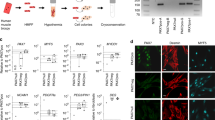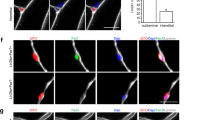Abstract
During vertebrate development, successive phases of embryonic and fetal myogenesis lead to the formation and growth of skeletal muscles1. Although the origin and molecular regulation of the earliest embryonic muscle cells is well understood2, less is known about later stages of myogenesis. We have identified a new cell population that expresses the transcription factors Pax3 and Pax7 (paired box proteins 3 and 7) but no skeletal-muscle-specific markers. These cells are maintained as a proliferating population in embryonic and fetal muscles of the trunk and limbs throughout development. Using a stable green fluorescent protein (GFP) reporter targeted to Pax3, we demonstrate that they constitute resident muscle progenitor cells that subsequently become myogenic and form skeletal muscle. Late in fetal development, these cells adopt a satellite cell position characteristic of progenitor cells in postnatal muscle. In the absence of both Pax3 and Pax7, further muscle development is arrested and only the early embryonic muscle of the myotome forms. Cells failing to express Pax3 or Pax7 die or assume a non-myogenic fate. We conclude that this resident Pax3/Pax7-dependent progenitor cell population constitutes a source of myogenic cells of prime importance for skeletal muscle formation, a finding also of potential value in the context of cell therapy for muscle disease.
This is a preview of subscription content, access via your institution
Access options
Subscribe to this journal
Receive 51 print issues and online access
$199.00 per year
only $3.90 per issue
Buy this article
- Purchase on Springer Link
- Instant access to full article PDF
Prices may be subject to local taxes which are calculated during checkout




Similar content being viewed by others
References
Cossu, G. in Advances in Developmental Biology and Biochemistry (ed. Wassarman, P. M.) 127–142 (Elsevier, San Diego, 2001)
Pownall, M. E., Gustafsson, M. K. & Emerson, C. P. Jr Myogenic regulatory factors and the specification of muscle progenitors in vertebrate embryos. Annu. Rev. Cell Dev. Biol. 18, 747–783 (2002)
Tremblay, P. et al. A crucial role for Pax3 in the development of the hypaxial musculature and the long-range migration of muscle precursors. Dev. Biol. 203, 49–61 (1998)
Borycki, A. G., Li, J., Jin, F., Emerson, C. P. & Epstein, J. A. Pax3 functions in cell survival and in pax7 regulation. Development 126, 1665–1674 (1999)
Buckingham, M. et al. The formation of skeletal muscle: from somite to limb. J. Anat. 202, 59–68 (2003)
Tajbakhsh, S., Rocancourt, D., Cossu, G. & Buckingham, M. Redefining the genetic hierarchies controlling skeletal myogenesis: Pax-3 and Myf-5 act upstream of MyoD. Cell 89, 127–138 (1997)
Kassar-Duchossoy, L. et al. Mrf4 determines skeletal muscle identity in Myf5:Myod double-mutant mice. Nature 431, 466–471 (2004)
Rudnicki, M. A. et al. MyoD or Myf-5 is required for the formation of skeletal muscle. Cell 75, 1351–1359 (1993)
Relaix, F., Rocancourt, D., Mansouri, A. & Buckingham, M. Divergent functions of murine Pax3 and Pax7 in limb muscle development. Genes Dev. 18, 1088–1105 (2004)
Seale, P. et al. Pax7 is required for the specification of myogenic satellite cells. Cell 102, 777–786 (2000)
Oustanina, S., Hause, G. & Braun, T. Pax7 directs postnatal renewal and propagation of myogenic satellite cells but not their specification. EMBO J. 23, 3430–3439 (2004)
Schubert, F. R. et al. Early mesodermal phenotypes in splotch suggest a role for Pax3 in the formation of epithelial somites. Dev. Dyn. 222, 506–521 (2001)
Williams, B. A. & Ordahl, C. P. Pax-3 expression in segmental mesoderm marks early stages in myogenic cell specification. Development 120, 785–796 (1994)
Bober, E., Franz, T., Arnold, H. H., Gruss, P. & Tremblay, P. Pax-3 is required for the development of limb muscles: a possible role for the migration of dermomyotomal muscle progenitor cells. Development 120, 603–612 (1994)
Goulding, M., Lumsden, A. & Paquette, A. J. Regulation of Pax-3 expression in the dermomyotome and its role in muscle development. Development 120, 957–971 (1994)
Tajbakhsh, S. & Buckingham, M. The birth of muscle progenitor cells in the mouse: spatiotemporal considerations. Curr. Top. Dev. Biol. 48, 225–268 (2000)
Jostes, B., Walther, C. & Gruss, P. The murine paired box gene, Pax7, is expressed specifically during the development of the nervous and muscular system. Mech. Dev. 33, 27–37 (1990)
Mansouri, A., Stoykova, A., Torres, M. & Gruss, P. Dysgenesis of cephalic neural crest derivatives in Pax7-/- mutant mice. Development 122, 831–838 (1996)
Kardon, G., Harfe, B. D. & Tabin, C. J. A Tcf4-positive mesodermal population provides a prepattern for vertebrate limb muscle patterning. Dev. Cell 5, 937–944 (2003)
Relaix, F. et al. The transcriptional activator PAX3-FKHR rescues the defects of Pax3 mutant mice but induces a myogenic gain-of-function phenotype with ligand-independent activation of Met signaling in vivo. Genes Dev. 17, 2950–2965 (2003)
Mauro, A. Satellite cell of skeletal muscle fibers. J. Biophys. Biochem. Cytol. 9, 493–495 (1961)
Armand, O., Boutineau, A. M., Mauger, A., Pautou, M. P. & Kieny, M. Origin of satellite cells in avian skeletal muscles. Arch. Anat. Microsc. Morphol. Exp. 72, 163–181 (1983)
Gros, J., Manceau, M., Thomé, V. & Marcelle, C. A common somitic origin for embryonic muscle progenitors and satellite cells. Nature advance online publication, 20 April 2005 (doi:10.1038/nature03572).
Tajbakhsh, S., Rocancourt, D. & Buckingham, M. Muscle progenitor cells failing to respond to positional cues adopt non-myogenic fates in myf-5 null mice. Nature 384, 266–270 (1996)
Ben-Yair, R. & Kalcheim, C. Lineage analysis of the avian dermomyotome sheet reveals the existence of single cells with both dermal and muscle progenitor fates. Development 132, 689–701 (2005)
Acknowledgements
We thank B. Williamson for critical reading of the manuscript and C. Bodin for histology work. This work was supported by the Pasteur Institute and the CNRS, with additional grants from the A.F.M., the ‘Cellules Souches’ Grand Programme Horizontal of the Pasteur Institute, the Cells into Organs Network of Excellence and the EuroStemCell Integrated Project of the EU Sixth Framework Programme.
Author information
Authors and Affiliations
Corresponding authors
Ethics declarations
Competing interests
The authors declare that they have no competing financial interests.
Supplementary information
Supplementary Figure S1
A population of muscle progenitor cells that express Pax3 and Pax7, but no myogenic markers are found in the developing limb and somites. The GFP reporter targeted to Pax3 is sufficiently stable to perdure in the myogenic derivatives of these cells. (JPG 453 kb)
Supplementary Figure S1 Legend
Full legend to accompany Supplementary Figure S1. (DOC 50 kb)
Supplementary Figure S2
Demonstration of the differential stabilities of LacZ and GFP reporters targeted to Pax7 and Pax3 respectively. This is shown for the neural tube where GFP continues to be detected in cells which have moved ventrally and no longer express Pax3. (JPG 141 kb)
Supplementary Figure S2 Legend
Full legend to accompany Supplementary Figure S2. (DOC 31 kb)
Supplementary Figure S3
Transcripts for the myogenic determination factor, Myf5, are still detectable in the Pax3/Pax7 double mutant. This indicates that the early myotome is formed in the absence of these Pax factors, which are essential for subsequent skeletal muscle formation. (JPG 151 kb)
Supplementary Figure Legend S3
Full legend to accompany Supplementary Figure S3. (DOC 23 kb)
Rights and permissions
About this article
Cite this article
Relaix, F., Rocancourt, D., Mansouri, A. et al. A Pax3/Pax7-dependent population of skeletal muscle progenitor cells. Nature 435, 948–953 (2005). https://doi.org/10.1038/nature03594
Received:
Accepted:
Published:
Issue Date:
DOI: https://doi.org/10.1038/nature03594
This article is cited by
-
In vitro-generated human muscle reserve cells are heterogeneous for Pax7 with distinct molecular states and metabolic profiles
Stem Cell Research & Therapy (2023)
-
Stage-specific nutritional management and developmental programming to optimize meat production
Journal of Animal Science and Biotechnology (2023)
-
Regenerative medicine: current research and perspective in pediatric surgery
Pediatric Surgery International (2023)
-
Lin28a maintains a subset of adult muscle stem cells in an embryonic-like state
Cell Research (2023)
-
miR-378-mediated glycolytic metabolism enriches the Pax7Hi subpopulation of satellite cells
Cell Regeneration (2022)
Comments
By submitting a comment you agree to abide by our Terms and Community Guidelines. If you find something abusive or that does not comply with our terms or guidelines please flag it as inappropriate.



